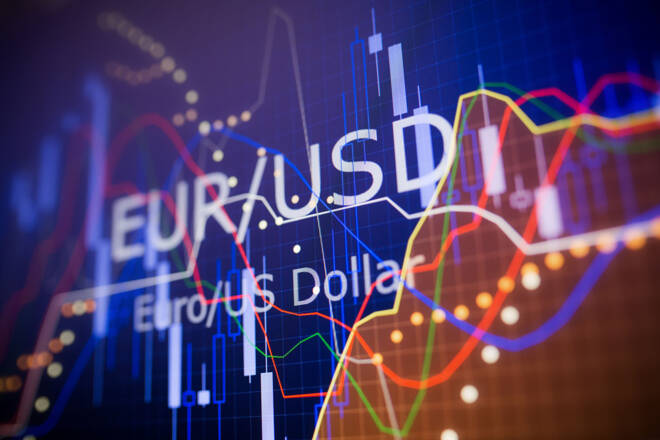Advertisement
Advertisement
EUR/USD Weekly Forecast: Private Sector PMIs and the ECB in the Spotlight
By:
US Q3 GDP and service sector PMIs will play a vital role in influencing the dollar's direction, while Fed Chair Powell's remarks add an element of uncertainty.
Highlights
- Euro area PMIs and the ECB to dictate demand for the EUR.
- Fed Chair Powell and a busy US economic calendar may decide the Fed interest rate path.
- The Middle East conflict warrants consideration. An escalation in the conflict would fuel demand for the US dollar.
Weekly Overview of Week Ending October 20, 2023
In the week ending on October 20, the EUR/USD gained 0.82%, ending the week at $1.05930. The EUR/USD fell to a Monday low of $1.05084 before reaching a Thursday high of $1.06164.
Euro Area Private Sector and the ECB in the Spotlight
Eurozone consumer confidence numbers for October will kickstart a pivotal week for the EUR on Monday. A deterioration in consumer confidence would signal a weak demand outlook. Private consumption accounts for over 50% of the Eurozone economy.
A weak demand outlook would reinforce expectations of a Eurozone recession. Notably, a downward trend in consumption would reduce pressure on the ECB to raise interest rates.
On Tuesday, prelim private sector PMIs for France, Germany, and the Eurozone will draw investor attention. The services sector will influence the EUR/USD more, accounting for over 75% of the economy. A larger-than-expected fall in the services PMIs would fuel recessionary fears and ease bets on ECB rate hikes.
Economists forecast the Eurozone Services PMI to slip from 48.7 to 48.6.
German consumer sentiment numbers are also out on Tuesday but will likely play second fiddle to the PMI numbers.
On Wednesday, German business sentiment will need consideration. A pickup in business sentiment will ease fears of a fall in business investment. However, the numbers are unlikely to influence ECB monetary policy decisions.
The ECB monetary policy decision and press conference will impact the buyer appetite for the EUR on Thursday. Economists expect the ECB to leave interest rates unchanged at 4.5%. Barring a surprise rate hike, the focus will be on the press conference. The outlook for inflation, the economy, and interest rates will be the focal points.
On Friday, the French economy will be in the spotlight. Q3 GDP, consumer confidence, and inflation warrant consideration. Softer-than-expected inflation numbers and an economic contraction would pressure the EUR/USD.
US Service Sector Activity, GDP, and Inflation in Focus
Prelim US private sector PMIs for October need consideration on Tuesday. The Services PMI will draw more investor interest, accounting for over 75% of the US economy. Beyond the headline PMI, investors must consider the sub-components, including employment, new orders, and prices.
Uptrends in hiring and wages would fuel demand-driven inflationary pressures, forcing the Fed to curb demand.
Economists predict the Services PMI to decline from 50.1 to 49.8.
Q3 GDP and jobless claims will influence investor appetite for the US dollar before a busy Friday session. Upbeat GDP numbers, a steady labor market, and a better-than-expected Services PMI may fuel bets on a Fed rate hike.
However, inflation, personal spending, and consumer sentiment figures will impact the EUR/USD on Friday. Sticky inflation, an uptrend in spending, and a pickup in consumer sentiment would drive demand for the US dollar. Upward trends in spending and sentiment fuel demand-driven inflationary pressures, forcing the Fed to keep rates higher for longer.
A more aggressive Fed rate path impacts borrowing costs and spending, easing demand-driven inflationary pressures.
Beyond the numbers, Fed Chair Powell will speak on Thursday. Fed monetary policy uncertainty will leave the EUR/USD sensitive to forward guidance.
Away from the economic calendar, an escalation in the Middle East conflict would drive demand for the US dollar, a safe haven currency.
Short-Term Forecast:
Near-term EUR/USD trends hinge on the PMI numbers before the ECB policy decision and press conference. While a dovish ECB hold would weigh on the EUR/USD, weak US economic indicators could support a solid end to the week for the EUR/USD.
EUR/USD Price Action
Daily Chart
The EUR/USD sat below the 50-day and 200-day EMAs, sending bearish price signals. A break above the $1.06342 resistance level would give the bulls a run at $1.07 and the $1.07635 resistance level.
Weaker-than-expected US Services PMI, GDP, and personal spending, coupled with softer inflation would fuel buying demand for the EUR/USD.
However, another set of solid US economic indicators and a dovish ECB policy decision may pressure the EUR/USD
A EUR/USD return to $1.05500 would support a break below the $1.05239 support level to target the October low of $1.04482.
The 14-period Daily RSI at 48.89 indicates a EUR/USD move to the $1.05230 resistance level before entering oversold territory.
4-Hour Chart
The EUR/USD hovers above the 50-day EMA while remaining below the 200-day EMA, sending bullish near-term but bearish longer-term price signals. A EUR/USD break above the 200-day EMA and $1.06342 resistance level would support a move toward the $1.07635 resistance level.
However, a fall through the 50-day EMA would bring the $1.05230 support level and sub-$1.05 into play.
The 14-period 4-Hourly RSI at 59.05 indicates a EUR/USD move to the 200-day EMA before entering overbought territory.
About the Author
Bob Masonauthor
With over 28 years of experience in the financial industry, Bob has worked with various global rating agencies and multinational banks. Currently he is covering currencies, commodities, alternative asset classes and global equities, focusing mostly on European and Asian markets.
Latest news and analysis
Advertisement
